Stewart J. Calculus
Подождите немного. Документ загружается.


EXAMPLE 2 The arc of the parabola from to is rotated about the
-axis. Find the area of the resulting surface.
SOLUTION 1 Using
and
we have, from Formula 8,
Substituting , we have . Remembering to change the limits of
integration, we have
SOLUTION 2 Using
and
we have
(where )
(as in Solution 1) M
EXAMPLE 3 Find the area of the surface generated by rotating the curve ,
, about the -axis.
SOLUTION Using Formula 5 with
and
dy
dx
! e
x
y ! e
x
x0 # x # 1
y ! e
x
V
!
!
6
(
17
s
17
' 5
s
5
)
u ! 1 " 4y !
!
4
y
17
5
s
u
du
! 2
!
y
4
1
s
y
!
1 "
1
4y
dy !
!
y
4
1
s
4y " 1
dy
S !
y
2
!
x ds !
y
4
1
2
!
x
!
1 "
"
dx
dy
#
2
dy
dx
dy
!
1
2
s
y
x !
s
y
!
!
6
(
17
s
17
' 5
s
5
)
S !
!
4
y
17
5
s
u
du !
!
4
[
2
3
u
3+2
]
5
17
du ! 8x dxu ! 1 " 4x
2
! 2
!
y
2
1
x
s
1 " 4x
2
dx
!
y
2
1
2
!
x
!
1 "
"
dy
dx
#
2
dx
S !
y
2
!
x ds
dy
dx
! 2xy ! x
2
y
$2, 4%$1, 1%y ! x
2
V
572
|| ||
CHAPTER 9 FURTHER APPLICATIONS OF INTEGRATION
(2,4)
y=≈
x
0
y
1 2
F I G U R E 7
N Figure 7 shows the surface of revolution
whose area is computed in Example 2.
N As a check on our answer to Example 2,
notice from Figure 7 that the surface area
should be close to that of a circular cylinder with
the same height and radius halfway between
the upper and lower radius of the surface:
. We computed that
the surface area was
which seems reasonable. Alternatively, the sur-
face area should be slightly larger than the area
of a frustum of a cone with the same top and
bottom edges. From Equation 2, this is
.2
!
$1.5%
(
s
10
)
* 29.80
!
6
(
17
s
17
' 5
s
5
)
* 30.85
2
!
$1.5%$3% * 28.27
N Another method: Use Formula 6 with
.x ! ln y
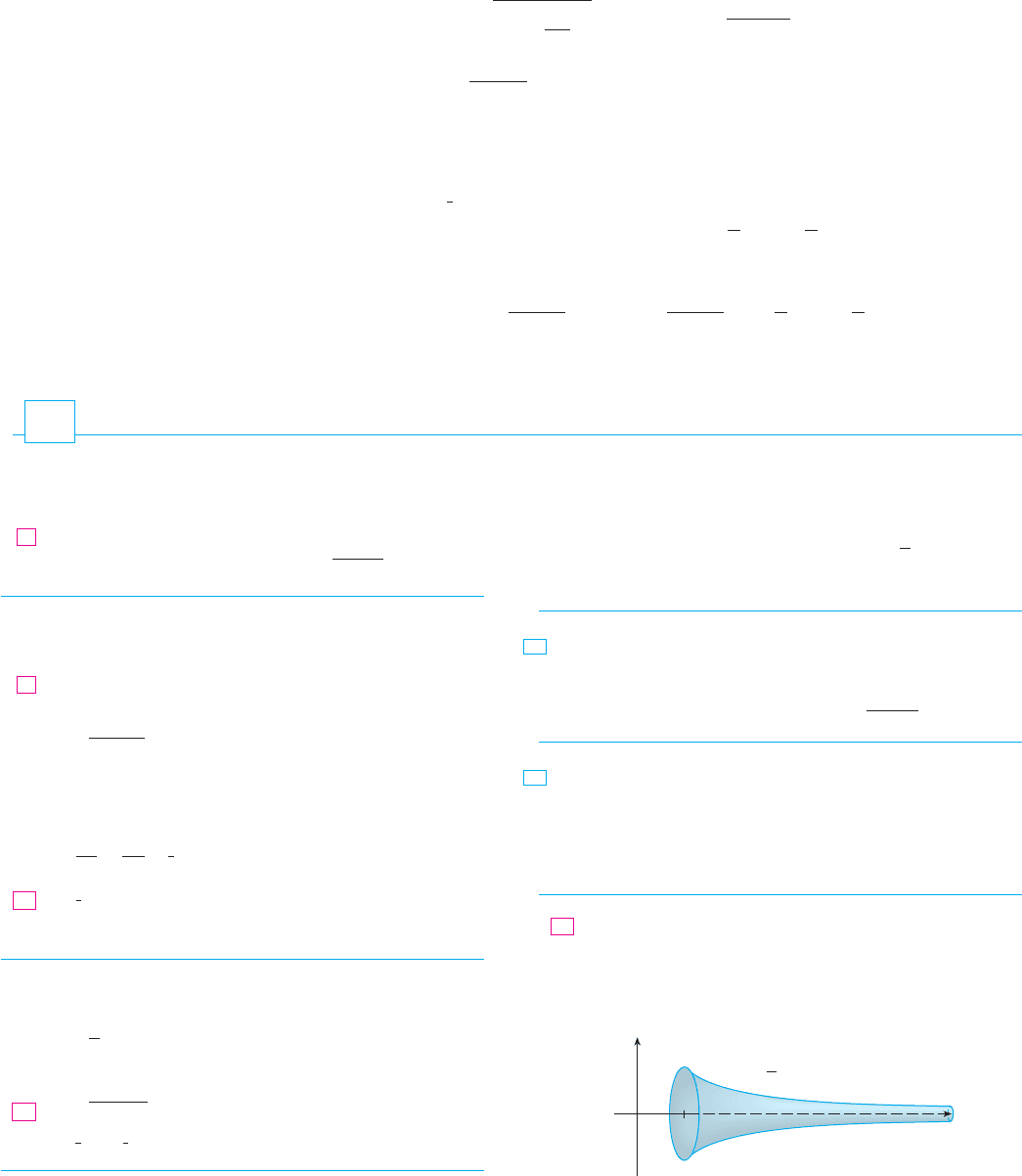
we have
(where )
(where and )
(by Example 8 in Section 8.2)
Since , we have and
M
S !
!
[
e
s
1 " e
2
" ln
(
e "
s
1 " e
2
)
'
s
2
' ln
(
s
2
" 1
)
]
sec
2
(
! 1 " tan
2
(
! 1 " e
2
tan
(
! e
!
!
[
sec
(
tan
(
" ln$sec
(
" tan
(
% '
s
2
' ln
(
s
2
" 1
)
]
! 2
!
!
1
2
[
sec
)
tan
)
" ln
)
sec
)
" tan
)
)
]
!
+4
(
(
! tan
'1
eu ! tan
)
! 2
!
y
(
!
+4
sec
3
)
d
)
u ! e
x
! 2
!
y
e
1
s
1 " u
2
du
S !
y
1
0
2
!
y
!
1 "
"
dy
dx
#
2
dx ! 2
!
y
1
0
e
x
s
1 " e
2x
dx
SECTION 9.2 AREA OF A SURFACE OF REVOLUTION
|| ||
573
17–20 Use Simpson’s Rule with to approximate the area
of the surface obtained by rotating the curve about the -axis.
Compare your answer with the value of the integral produced by
your calculator.
17. , 18. ,
19. , 20. ,
21–22 Use either a CAS or a table of integrals to find the exact
area of the surface obtained by rotating the given curve about the
-axis.
21. , 22. ,
23–24 Use a CAS to find the exact area of the surface obtained
by rotating the curve about the -axis. If your CAS has trouble
evaluating the integral, express the surface area as an integral in
the other variable.
23. , 24. ,
If the region is rotated
about the -axis, the volume of the resulting solid is finite
(see Exercise 63 in Section 8.8). Show that the surface area is
infinite. (The surface is shown in the figure and is known as
Gabriel’s horn.)
0
1
1
x
y=
y
x
x
! ! ,$x, y%
)
x * 1, 0 # y # 1+x-
25.
0 # x # 1y ! ln$x " 1%0 # y # 1y ! x
3
y
CAS
0 # x # 3y !
s
x
2
" 1
1 # x # 2y ! 1+x
x
CAS
0 # x # 1y ! e
'x
2
0 # x #
!
+3y ! sec x
1 # x # 2y ! x "
s
x
1 # x # 3y ! ln x
x
n ! 10
1– 4 Set up, but do not evaluate, an integral for the area of the
surface obtained by rotating the curve about (a) the -axis and
(b) the -axis.
,
2. ,
3. , 4.
5–12 Find the area of the surface obtained by rotating the curve
about the -axis.
,
6. ,
7. ,
8. ,
9. ,
10. ,
,
12. ,
13–16 The given curve is rotated about the -axis. Find the area
of the resulting surface.
13. ,
14. ,
,
16. , 1 # x # 2y !
1
4
x
2
'
1
2
ln x
0 # y # a+2x !
s
a
2
' y
2
15.
0 # x # 1y ! 1 ' x
2
1 # y # 2y !
s
3
x
y
1 # y # 2x ! 1 " 2y
2
1 # y # 2x !
1
3
$y
2
" 2%
3+2
11.
1
2
# x # 1y !
x
3
6
"
1
2x
0 # x # 1y ! sin
!
x
0 # x # ay ! c " a cosh$x+a%
1 # x # 5y !
s
1 " 4x
2 # x # 69x ! y
2
" 18
0 # x # 2y ! x
3
5.
x
x !
s
y ' y
2
0 # x # 1y ! tan
'1
x
1 # x # 3y ! xe
'x
0 # x # 1y ! x
4
1.
y
x
E X E R C I S E S
9.2
N Or use Formula 21 in the Table of Integrals.
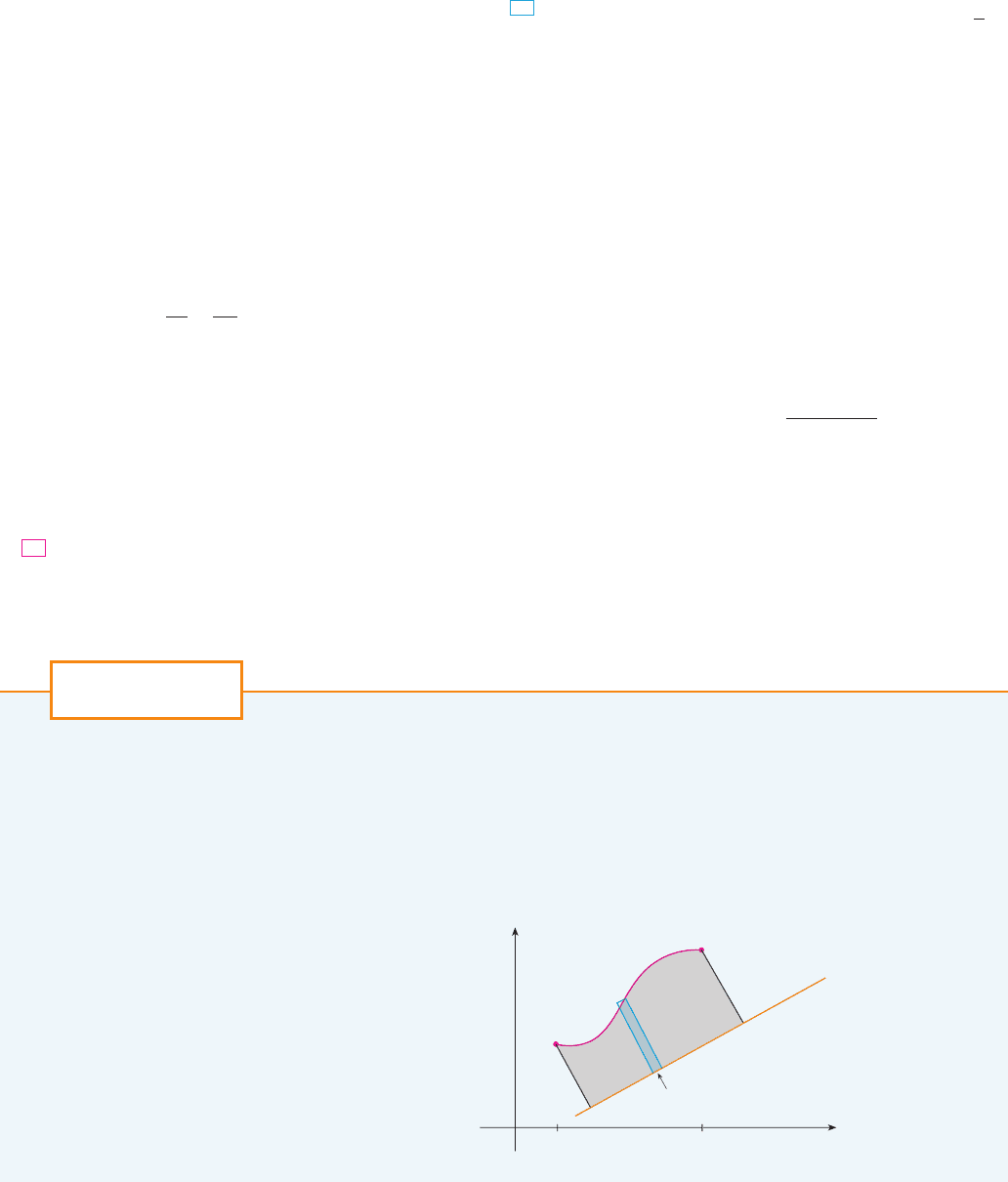
32. Use the result of Exercise 31 to set up an integral to find the
area of the surface generated by rotating the curve ,
, about the line . Then use a CAS to evaluate
the integral.
33. Find the area of the surface obtained by rotating the circle
about the line .
34. Show that the surface area of a zone of a sphere that lies
between two parallel planes is , where is the diam-
eter of the sphere and is the distance between the planes.
(Notice that depends only on the distance between the
planes and not on their location, provided that both planes
intersect the sphere.)
35. Formula 4 is valid only when . Show that when
is not necessarily positive, the formula for surface area
becomes
36. Let be the length of the curve , , where
is positive and has a continuous derivative. Let be the
surface area generated by rotating the curve about the -axis.
If is a positive constant, define and let
be the corresponding surface area generated by the curve
, . Express in terms of and .LS
f
S
t
a # x # by ! t$x%
S
t
t$x% ! f $x% " cc
x
S
f
f
a # x # by ! f $x%L
S !
y
b
a
2
!
)
f $x%
)
s
1 " & f $$x%'
2
dx
f $x%
f $x% * 0
S
h
dS !
!
dh
y ! rx
2
" y
2
! r
2
y ! 40 # x # 4
y !
s
x
CAS
26. If the infinite curve , , is rotated about the
-axis, find the area of the resulting surface.
27. (a) If , find the area of the surface generated by rotating
the loop of the curve about the -axis.
(b) Find the surface area if the loop is rotated about the
-axis.
28. A group of engineers is building a parabolic satellite dish
whose shape will be formed by rotating the curve
about the -axis. If the dish is to have a 10-ft diameter and a
maximum depth of 2 ft, find the value of and the surface
area of the dish.
29. (a) The ellipse
is rotated about the -axis to form a surface called an
ellipsoid, or prolate spheroid. Find the surface area of this
ellipsoid.
(b) If the ellipse in part (a) is rotated about its minor axis (the
-axis), the resulting ellipsoid is called an oblate spheroid.
Find the surface area of this ellipsoid.
30. Find the surface area of the torus in Exercise 63 in
Section 6.2.
If the curve , , is rotated about the
horizontal line , where , find a formula for the
area of the resulting surface.
f $x% # cy ! c
a # x # by ! f $x%
31.
y
x
a + b
x
2
a
2
"
y
2
b
2
! 1
a
y
y ! ax
2
y
x3ay
2
! x$a ' x%
2
a + 0
x
x * 0y ! e
'x
574
|| ||
CHAPTER 9 FURTHER APPLICATIONS OF INTEGRATION
We know how to find the volume of a solid of revolution obtained by rotating a region about a
horizontal or vertical line (see Section 6.2). We also know how to find the surface area of a sur-
face of revolution if we rotate a curve about a horizontal or vertical line (see Section 9.2). But
what if we rotate about a slanted line, that is, a line that is neither horizontal nor vertical? In this
project you are asked to discover formulas for the volume of a solid of revolution and for the
area of a surface of revolution when the axis of rotation is a slanted line.
Let be the arc of the curve between the points and and let
be the region bounded by , by the line (which lies entirely below ), and by the
perpendiculars to the line from and .
P
0
x
y
q
p
!
C
Q
y=ƒ
y=mx+b
Îu
QP
Cy ! mx " bC
!Q$q, f $q%%P$p, f $ p%%y ! f $x%C
ROTATING ON A SLANT
D I S C O V E R Y
P R O J E C T
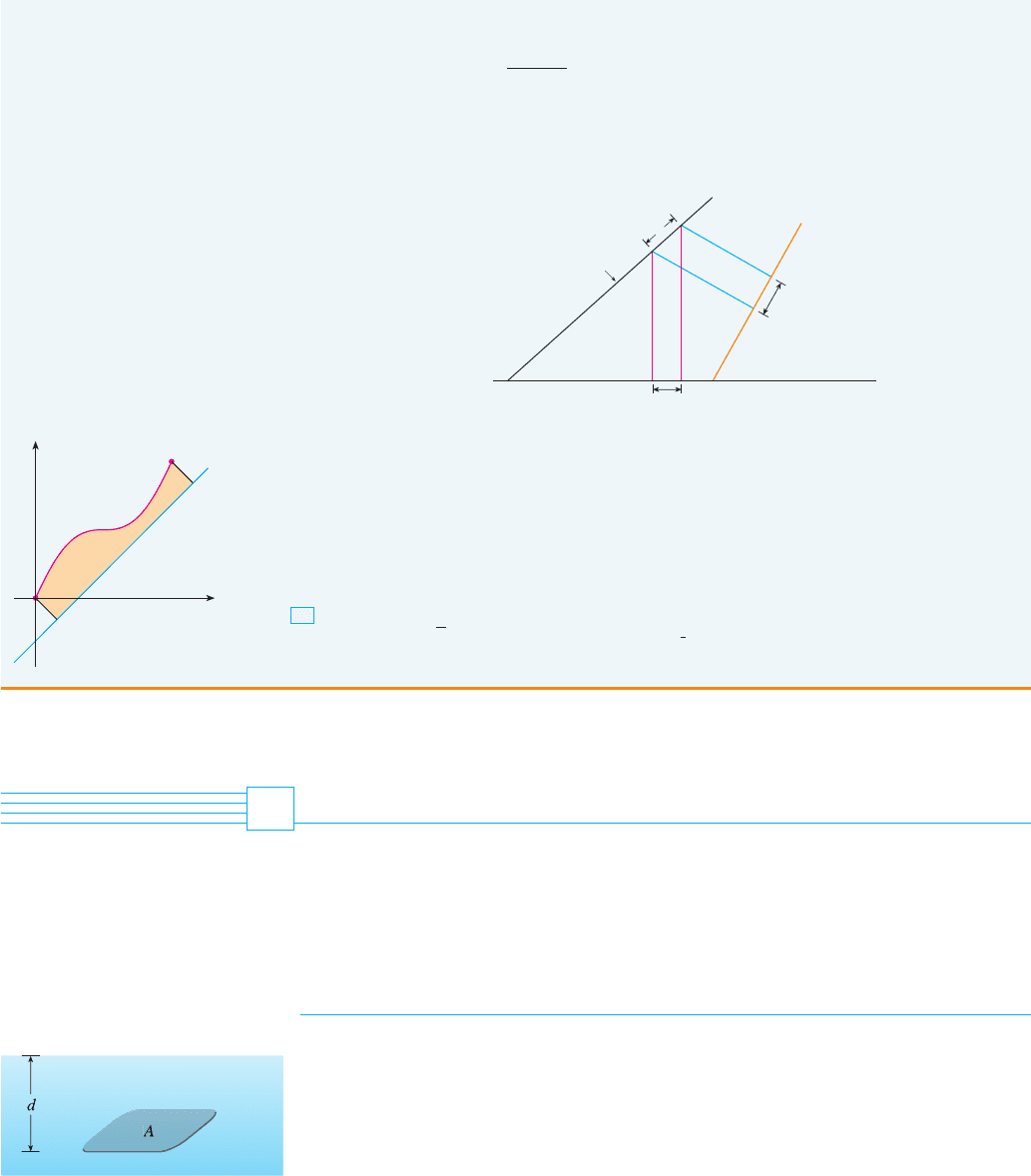
1.
Show that the area of is
[Hint: This formula can be verified by subtracting areas, but it will be helpful throughout the
project to derive it by first approximating the area using rectangles perpendicular to the line,
as shown in the figure. Use the figure to help express in terms of .]
2.
Find the area of the region shown in the figure at the left.
3.
Find a formula similar to the one in Problem 1 for the volume of the solid obtained by
rotating about the line .
4.
Find the volume of the solid obtained by rotating the region of Problem 2 about the
line .
5.
Find a formula for the area of the surface obtained by rotating about the line .
6.
Use a computer algebra system to find the exact area of the surface obtained by rotating the
curve , , about the line . Then approximate your result to three
decimal places.
y !
1
2
x0 # x # 4y !
s
x
CAS
y ! mx " bC
y ! x ' 2
y ! mx " b!
y=mx+b
Îu
å
tangent to C
at
{
x
i
, f(x
i
)
}
x
i
∫
?
Îx
?
&x&u
1
1 " m
2
y
q
p
& f $x% ' mx ' b'&1 " mf $$x%' dx
!
SECTION 9.3 APPLICATIONS TO PHYSICS AND ENGINEERING
|| ||
575
y
x
0
(2π,2π)
y=x+sinx
y=x-2
APP LIC ATI ONS TO P HYS ICS AN D EN GIN E ERI NG
Among the many applications of integral calculus to physics and engineering, we consider
two here: force due to water pressure and centers of mass. As with our previous applica-
tions to geometry (areas, volumes, and lengths) and to work, our strategy is to break up the
physical quantity into a large number of small parts, approximate each small part, add the
results, take the limit, and then evaluate the resulting integral.
HYDRO S TATIC FORCE A N D PR E S S U R E
Deep-sea divers realize that water pressure increases as they dive deeper. This is because
the weight of the water above them increases.
In general, suppose that a thin horizontal plate with area square meters is submerged
in a fluid of density kilograms per cubic meter at a depth meters below the surface of
the fluid as in Figure 1. The fluid directly above the plate has volume , so its mass
is . The force exerted by the fluid on the plate is therefore
F ! mt !
,
tAd
m !
,
V !
,
Ad
V ! Ad
d
,
A
9.3
surface o
f
fl
ui
d
F I G U R E
1
Openmirrors.com
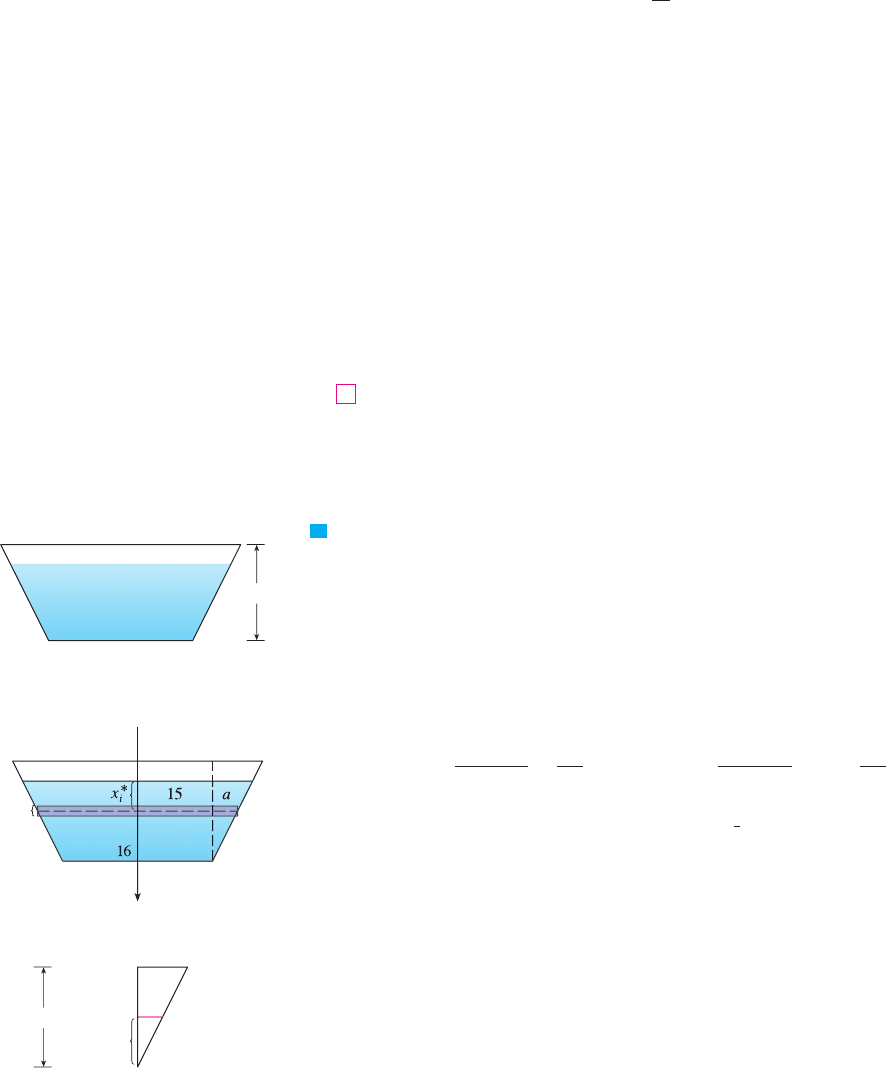
where is the acceleration due to gravity. The pressure on the plate is defined to be the
force per unit area:
The SI unit for measuring pressure is newtons per square meter, which is called a pascal
(abbreviation: 1 N+m Pa). Since this is a small unit, the kilopascal (kPa) is often
used. For instance, because the density of water is , the pressure at the
bottom of a swimming pool 2 m deep is
An important principle of fluid pressure is the experimentally verified fact that at any
point in a liquid the pressure is the same in all directions. (A diver feels the same pressure
on nose and both ears.) Thus the pressure in any direction at a depth in a fluid with mass
density is given by
This helps us determine the hydrostatic force against a vertical plate or wall or dam in a
fluid. This is not a straightforward problem because the pressure is not constant but
increases as the depth increases.
EXAMPLE 1 A dam has the shape of the trapezoid shown in Figure 2. The height is
20 m, and the width is 50 m at the top and 30 m at the bottom. Find the force on the dam
due to hydrostatic pressure if the water level is 4 m from the top of the dam.
SOLUTION We choose a vertical -axis with origin at the surface of the water as in
Figure 3(a). The depth of the water is 16 m, so we divide the interval into sub-
intervals of equal length with endpoints and we choose . The hori-
zontal strip of the dam is approximated by a rectangle with height and width ,
where, from similar triangles in Figure 3(b),
or
and so
If is the area of the strip, then
If is small, then the pressure on the strip is almost constant and we can use
Equation 1 to write
The hydrostatic force acting on the strip is the product of the pressure and the
area:
F
i
! P
i
A
i
* 1000tx
i
*
$46 ' x
i
*
% &x
ithF
i
P
i
* 1000tx
i
*
ithP
i
&x
A
i
* w
i
&x ! $46 ' x
i
*
% &x
ithA
i
w
i
! 2$15 " a% ! 2
(
15 " 8 '
1
2
x
i
*
)
! 46 ' x
i
*
a !
16 ' x
i
*
2
! 8 '
x
i
*
2
a
16 ' x
i
*
!
10
20
w
i
&x
ithx
i
*
" &x
i'1
, x
i
'x
i
&0, 16'
x
V
P !
,
td !
-
d
1
,
d
! 19,600 Pa ! 19.6 kPa
P !
,
td ! 1000 kg+m
3
. 9.8 m+s
2
. 2 m
,
! 1000 kg+m
3
2
! 1
P !
F
A
!
,
td
Pt
576
|| ||
CHAPTER 9 FURTHER APPLICATIONS OF INTEGRATION
50 m
20 m
30 m
F I G U R E 2
F I
G U
R E
3
(b)
a
1
0
1
6
-
x
i
*
20
(
a
)
x
0
_4
1
5
1
5
10
Î
x
N When using US Customary units, we write
, where is the
weight
density
(as opposed to , which is the
mass
density
). For instance, the weight density of
water is .
-
! 62.5 lb+ft
3
,
-
!
,
tP !
,
td !
-
d
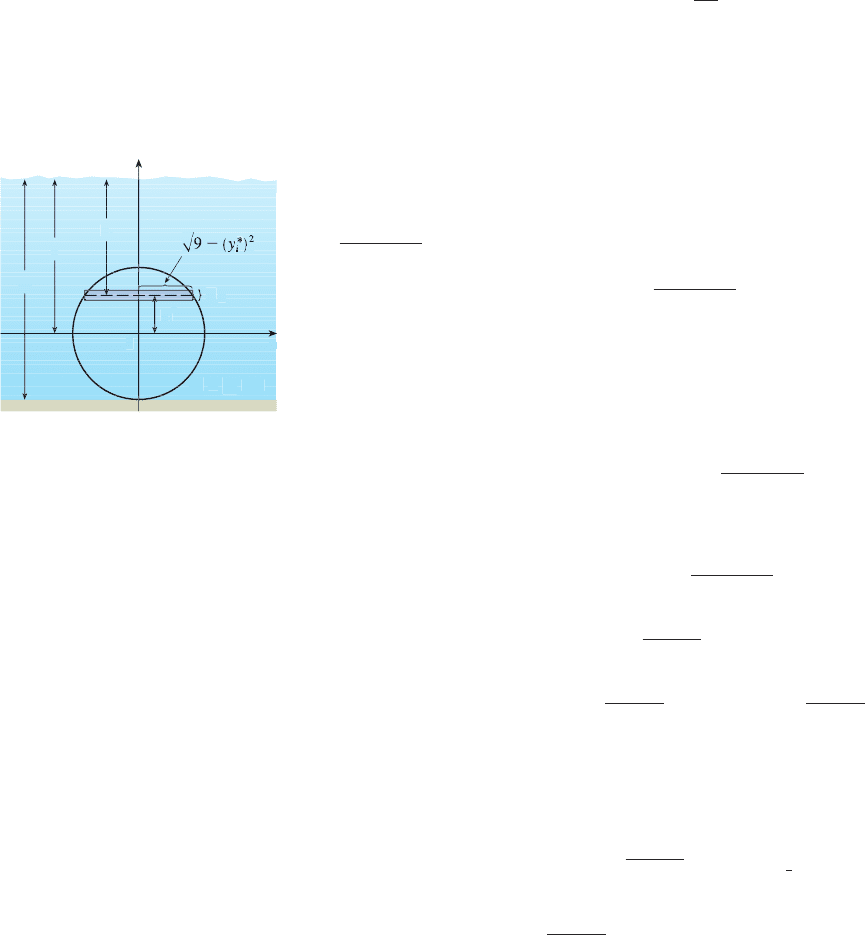
Adding these forces and taking the limit as , we obtain the total hydrostatic force
on the dam:
M
EXAMPLE 2 Find the hydrostatic force on one end of a cylindrical drum with radius 3 ft
if the drum is submerged in water 10 ft deep.
SOLUTION In this example it is convenient to choose the axes as in Figure 4 so that the
origin is placed at the center of the drum. Then the circle has a simple equation,
. As in Example 1 we divide the circular region into horizontal strips of
equal width. From the equation of the circle, we see that the length of the strip is
and so its area is
The pressure on this strip is approximately
and so the force on the strip is approximately
The total force is obtained by adding the forces on all the strips and taking the limit:
The second integral is 0 because the integrand is an odd function (see Theorem 5.5.6).
The first integral can be evaluated using the trigonometric substitution , but
it’s simpler to observe that it is the area of a semicircular disk with radius 3. Thus
M
!
7875
!
2
* 12,370 lb
F ! 875
y
3
'3
s
9 ' y
2
dy ! 875 !
1
2
!
$3%
2
y ! 3 sin
)
! 125 ! 7
y
3
'3
s
9 ' y
2
dy ' 125
y
3
'3
y
s
9 ' y
2
dy
! 125
y
3
'3
$7 ' y%
s
9 ' y
2
dy
F ! lim
n
l
%
(
n
i!1
62.5$7 ' y
i
*
%2
s
9 ' $y
i
*
%
2
&y
-
d
i
A
i
! 62.5$7 ' y
i
*
%2
s
9 ' $y
i
*
%
2
&y
-
d
i
! 62.5$7 ' y
i
*
%
A
i
! 2
s
9 ' $y
i
*
%
2
&y
2
s
9 ' $y
i
*
%
2
ith
x
2
" y
2
! 9
* 4.43 . 10
7
N
! 9800
.
23x
2
'
x
3
3
/
0
16
! 1000$9.8%
y
16
0
$46x ' x
2
%
dx
!
y
16
0
1000tx$46 ' x% dx
F ! lim
n
l
%
(
n
i!1
1000tx
i
*
$46 ' x
i
*
% &x
n l %
SECTION 9.3 APPLICATIONS TO PHYSICS AND ENGINEERING
|| ||
577
F I
G
U R E
4
œ
œ„„„„„„„
œ
œ
œ
œ
œ
œ
œ
œ
œ„
œ„
œ
œ
œ
œ
œ
œ
œ
œ
œ
œ
(
y
i
)
x
x
x
x
0
0
0
0
y
10
10
10
10
7
7
7
7
7
d
d
d
d
i
i
i
i
≈
≈
≈
≈
≈
≈
+
+
+
+
¥
¥
¥
¥
¥
¥
=9
9
=9
=9
9
y
y
y
y
i
i
i
i
*
*
*
Î
Î
Î
Î
Î
y
y
y
y
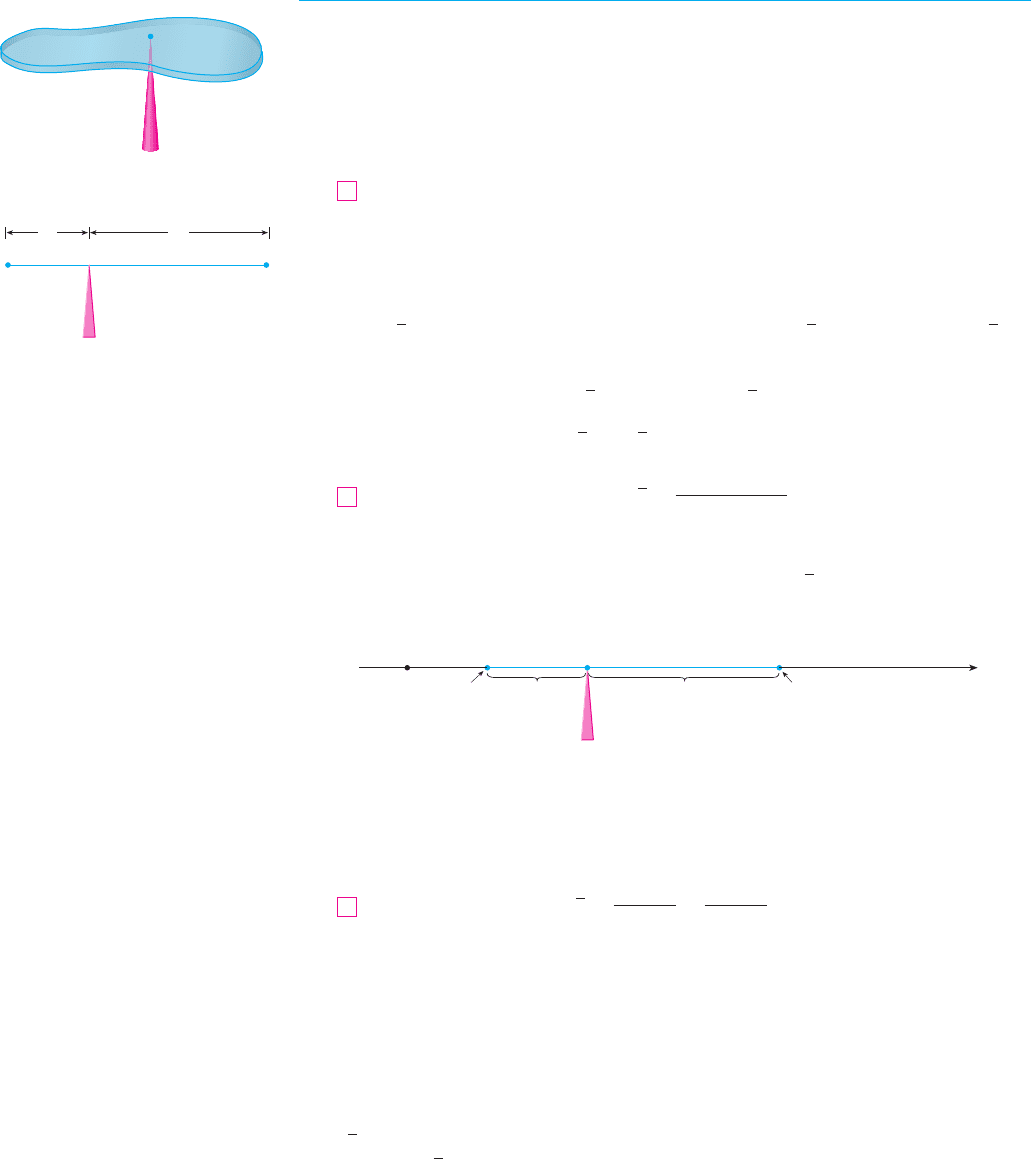
MOMENTS A N D C E N T E R S O F M A S S
Our main objective here is to find the point on which a thin plate of any given shape bal-
ances horizontally as in Figure 5. This point is called the center of mass (or center of grav-
ity) of the plate.
We first consider the simpler situation illustrated in Figure 6, where two masses and
are attached to a rod of negligible mass on opposite sides of a fulcrum and at distances
and from the fulcrum. The rod will balance if
This is an experimental fact discovered by Archimedes and called the Law of the Lever.
(Think of a lighter person balancing a heavier one on a seesaw by sitting farther away from
the center.)
Now suppose that the rod lies along the -axis with at and at and the center
of mass at . If we compare Figures 6 and 7, we see that and and
so Equation 2 gives
The numbers and are called the moments of the masses and (with respect
to the origin), and Equation 3 says that the center of mass is obtained by adding the
moments of the masses and dividing by the total mass .
In general, if we have a system of particles with masses , . . . , located at the
points , . . . , on the -axis, it can be shown similarly that the center of mass of the
system is located at
where is the total mass of the system, and the sum of the individual moments
is called the moment of the system about the origin. Then Equation 4 could be rewritten
as , which says that if the total mass were considered as being concentrated at the
center of mass , then its moment would be the same as the moment of the system.x
mx ! M
M !
(
n
i!1
m
i
x
i
m !
0
m
i
x !
(
n
i!1
m
i
x
i
(
n
i!1
m
i
!
(
n
i!1
m
i
x
i
m
4
xx
n
x
2
,x
1
m
n
m
2
,m
1
n
0
⁄
–
x
¤
¤-x
–
m¡ m™
x
–
x-⁄
F I G U R E 7
m ! m
1
" m
2
x
m
2
m
1
m
2
x
2
m
1
x
1
x !
m
1
x
1
" m
2
x
2
m
1
" m
2
3
m
1
x " m
2
x ! m
1
x
1
" m
2
x
2
m
1
$x ' x
1
% ! m
2
$x
2
' x%
d
2
! x
2
' xd
1
! x ' x
1
x
x
2
m
2
x
1
m
1
x
m
1
d
1
! m
2
d
2
2
d
2
d
1
m
2
m
1
P
578
|| ||
CHAPTER 9 FURTHER APPLICATIONS OF INTEGRATION
F I G U R E 5
P
F I G U R E 6
m¡ m™
d¡
fulcrum
d™
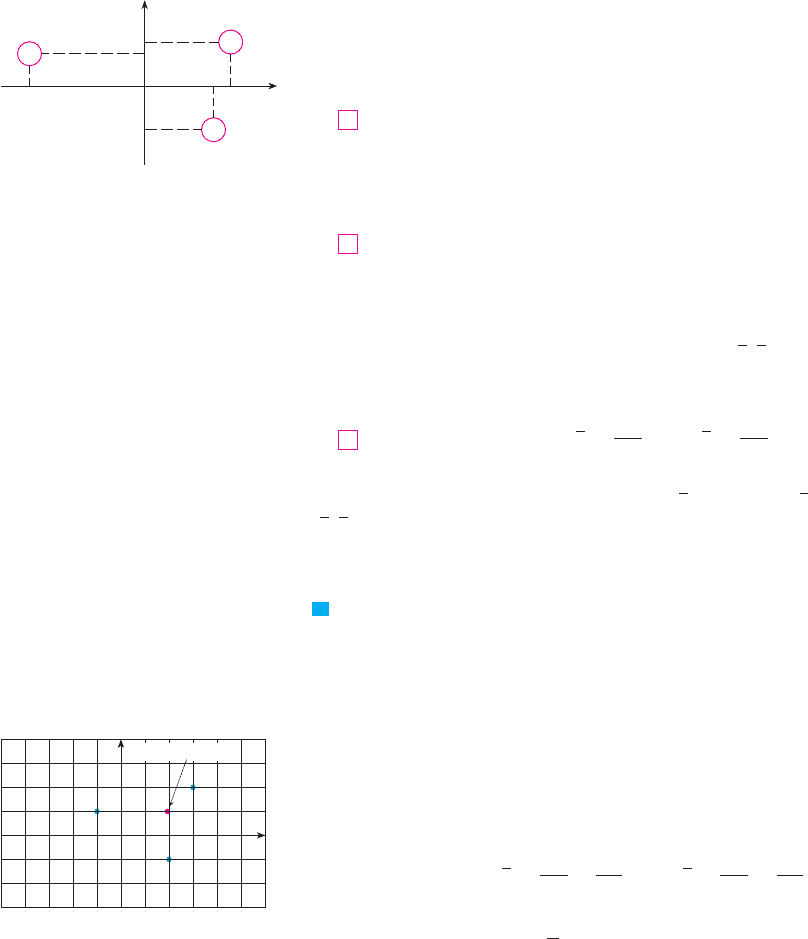
Now we consider a system of particles with masses , . . . , located at the
points , , . . . , in the -plane as shown in Figure 8. By analogy with
the one-dimensional case, we define the moment of the system about the y-axis to be
and the moment of the system about the x-axis as
Then measures the tendency of the system to rotate about the -axis and measures
the tendency to rotate about the -axis.
As in the one-dimensional case, the coordinates of the center of mass are given
in terms of the moments by the formulas
where is the total mass. Since and , the center of mass
is the point where a single particle of mass would have the same moments as the
system.
EXAMPLE 3 Find the moments and center of mass of the system of objects that have
masses 3, 4, and 8 at the points , , and , respectively.
SOLUTION We use Equations 5 and 6 to compute the moments:
Since , we use Equations 7 to obtain
Thus the center of mass is . (See Figure 9.)
M
Next we consider a flat plate (called a lamina) with uniform density that occupies a
region of the plane. We wish to locate the center of mass of the plate, which is called
the centroid of . In doing so we use the following physical principles: The symmetry
principle says that if is symmetric about a line , then the centroid of lies on . (If
is reflected about , then remains the same so its centroid remains fixed. But the only
fixed points lie on .) Thus the centroid of a rectangle is its center. Moments should be
defined so that if the entire mass of a region is concentrated at the center of mass, then its
moments remain unchanged. Also, the moment of the union of two nonoverlapping regions
should be the sum of the moments of the individual regions.
l
!l
!l!l!
!
!
,
(
1
14
15
, 1
)
y !
M
x
m
!
15
15
! 1x !
M
y
m
!
29
15
m ! 3 " 4 " 8 ! 15
M
x
! 3$1% " 4$'1% " 8$2% ! 15
M
y
! 3$'1% " 4$2% " 8$3% ! 29
$3, 2%$2, '1%$'1, 1%
V
m$x, y %
my ! M
x
mx ! M
y
m !
0
m
i
y !
M
x
m
x !
M
y
m
7
$x, y%
x
M
x
yM
y
M
x
!
(
n
i!1
m
i
y
i
6
M
y
!
(
n
i!1
m
i
x
i
5
xy$x
n
, y
n
%$x
2
, y
2
%$x
1
, y
1
%
m
n
m
2
,m
1
n
SECTION 9.3 APPLICATIONS TO PHYSICS AND ENGINEERING
|| ||
579
m£
m¡
m™
y
0
x
‹
y£
⁄
›
¤
fi
F I G U R E 8
F I G U R E 9
y
0
x
8
4
3
center of mass
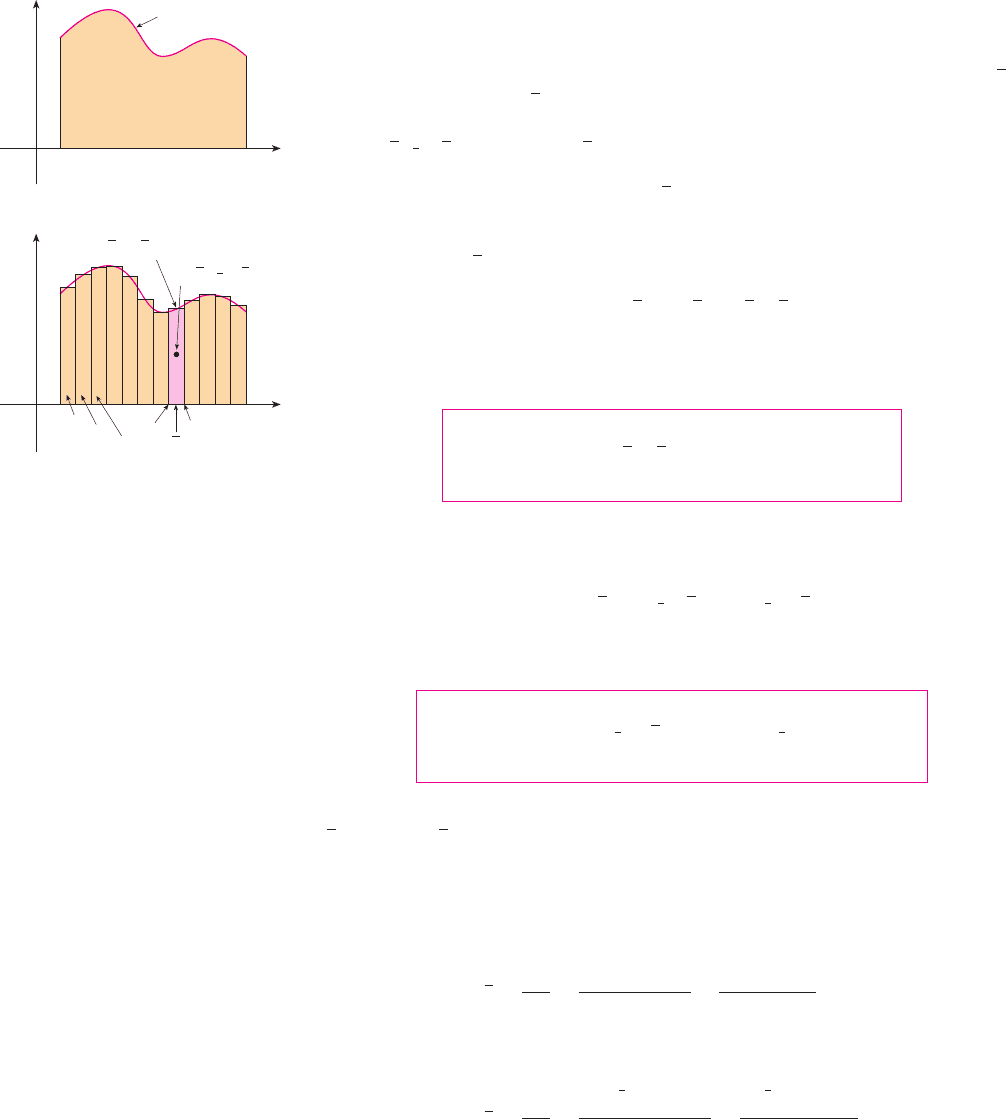
Suppose that the region is of the type shown in Figure 10(a); that is, lies between
the lines and , above the -axis, and beneath the graph of , where is a
continuous function. We divide the interval into n subintervals with endpoints
and equal width . We choose the sample point to be the midpoint of
the th subinterval, that is, . This determines the polygonal approxima-
tion to shown in Figure 10(b). The centroid of the th approximating rectangle is its
center . Its area is , so its mass is
The moment of about the -axis is the product of its mass and the distance from to
the -axis, which is
Adding these moments, we obtain the moment of the polygonal approximation to , and
then by taking the limit as we obtain the moment of itself about the -axis:
In a similar fashion we compute the moment of about the -axis as the product of its
mass and the distance from to the -axis:
Again we add these moments and take the limit to obtain the moment of about the
-axis:
Just as for systems of particles, the center of mass of the plate is defined so that
and . But the mass of the plate is the product of its density and its area:
and so
Notice the cancellation of the ’s. The location of the center of mass is independent of the
density.
!
y !
M
x
m
!
!
y
b
a
1
2
! f "x#$
2
dx
!
y
b
a
f "x# dx
!
y
b
a
1
2
! f "x#$
2
dx
y
b
a
f "x# dx
x
!
M
y
m
!
!
y
b
a
x f "x# dx
!
y
b
a
f "x# dx
!
y
b
a
x f "x# dx
y
b
a
f "x# dx
m !
!
A !
!
y
b
a
f "x# dx
my
! M
x
mx ! M
y
M
x
! lim
n
l
"
%
n
i!1
!
!
1
2
! f "x
i
#$
2
#x !
!
y
b
a
1
2
! f "x#$
2
dx
x
!
M
x
"R
i
# ! !
!
f "x
i
# #x$
1
2
f "x
i
# !
!
!
1
2
! f "x
i
#$
2
#x
xC
i
xR
i
M
y
! lim
n
l
"
%
n
i!1
!
x
i
f "x
i
# #x !
!
y
b
a
x f "x# dx
y!n l "
!
M
y
"R
i
# ! !
!
f "x
i
# #x$ x
i
!
!
x
i
f "x
i
# #x
x
i
. Thusy
C
i
yR
i
!
f "x
i
# #x
f "x
i
# #xC
i
(
x
i
,
1
2
f "x
i
#
)
R
i
i!
x
i
! "x
i$1
% x
i
#&2i
x
i
x
i
*
#xx
0
, x
1
, . . . , x
n
!a, b$
ffxx ! bx ! a
!!
580
|| ||
CHAPTER 9 FURTHER APPLICATIONS OF INTEGRATION
C
i
”
x
i
, f(x
i
)
’
x
i
F I G U R E 1 0
y
0
x
a b
R¡
R™
R£
x
i_1
x
i
{
x
i
,f(x
i
)
}
1
2
(b)
y
0
x
a b
y=ƒ
!
(a)
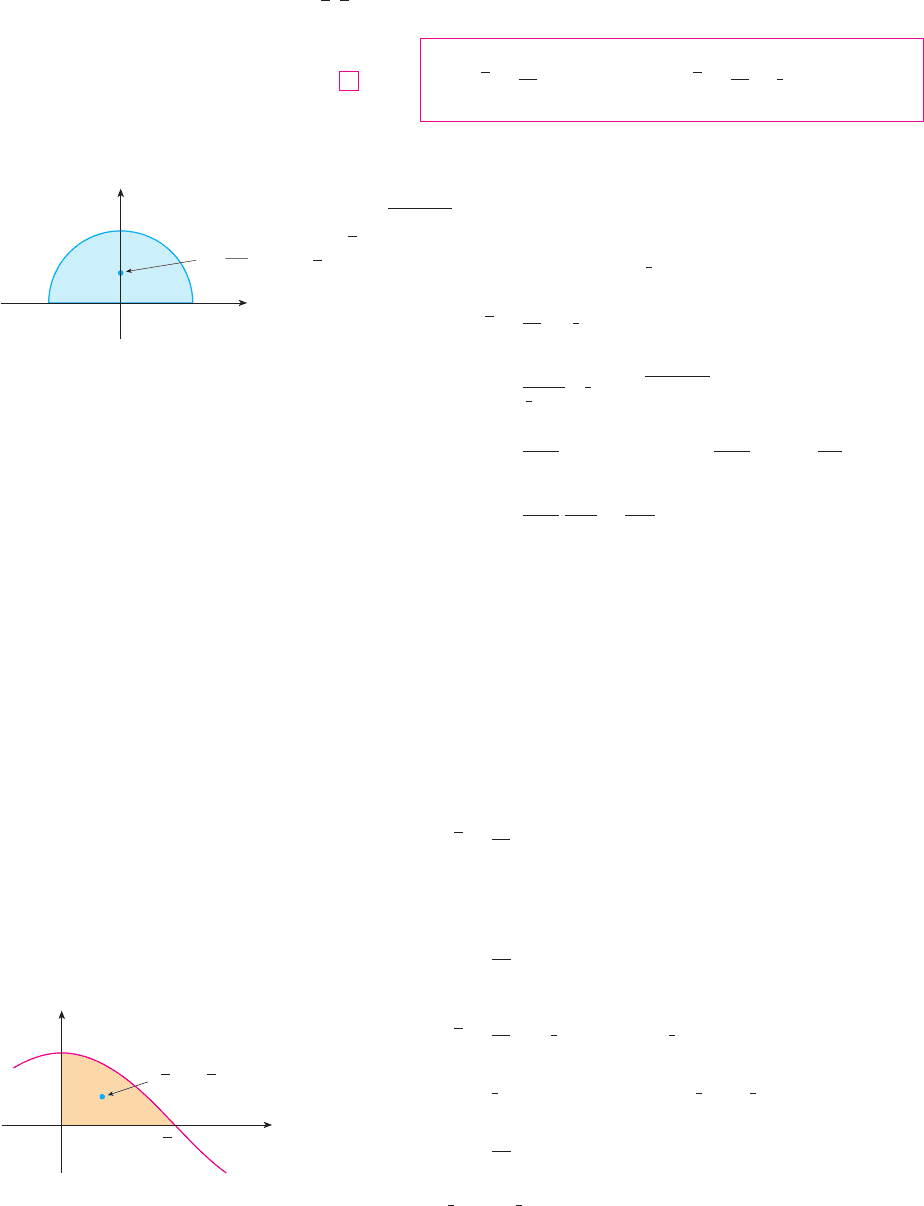
In summary, the center of mass of the plate (or the centroid of ) is located at the point
, where
EXAMPLE 4 Find the center of mass of a semicircular plate of radius .
SOLUTION In order to use (8) we place the semicircle as in Figure 11 so that
and , . Here there is no need to use the formula to calcu-
late because, by the symmetry principle, the center of mass must lie on the -axis, so
. The area of the semicircle is , so
The center of mass is located at the point .
M
EXAMPLE 5 Find the centroid of the region bounded by the curves , ,
, and .
SOLUTION The area of the region is
so Formulas 8 give
(by integration by parts)
The centroid is and is shown in Figure 12. M
(
1
2
&
$ 1,
1
8
&
)
!
&
8
!
1
4
y
&
&2
0
"1 % cos 2x# dx !
1
4
[
x %
1
2
sin 2x
]
0
&
&2
y !
1
A
y
&
&2
0
1
2
! f "x#$
2
dx !
1
2
y
&
&2
0
cos
2
x dx
!
&
2
$ 1
! x sin x
]
0
&
&2
$
y
&
&2
0
sin x dx
x
!
1
A
y
&
&2
0
x f "x# dx !
y
&
&2
0
x cos x dx
A !
y
&
&2
0
cos x dx ! sin x
]
0
&
&2
! 1
x !
&
&2x ! 0
y ! 0y ! cos x
"0, 4r&"3
&
##
!
2
&
r
2
2r
3
3
!
4r
3
&
!
2
&
r
2
y
r
0
"r
2
$ x
2
#
dx !
2
&
r
2
'
r
2
x $
x
3
3
(
0
r
!
1
1
2
&
r
2
!
1
2
y
r
$r
(
s
r
2
$ x
2
)
2
dx
y !
1
A
y
r
$r
1
2
! f "x#$
2
dx
A !
1
2
&
r
2
x ! 0
yx
b ! ra ! $rf "x# !
s
r
2
$ x
2
r
y !
1
A
y
b
a
1
2
! f "x#$
2
dxx !
1
A
y
b
a
x f "x# dx
8
"x, y#
!
SECTION 9.3 APPLICATIONS TO PHYSICS AND ENGINEERING
|| ||
581
x
y
r
0
_r
”0,
’
4r
3π
y= r@-≈
œ
„„„„„
F I G U R E 1 1
x
y
0
” -1, ’
π
8
π
2
π
2
F I G U R E 1 2
y=cos x
